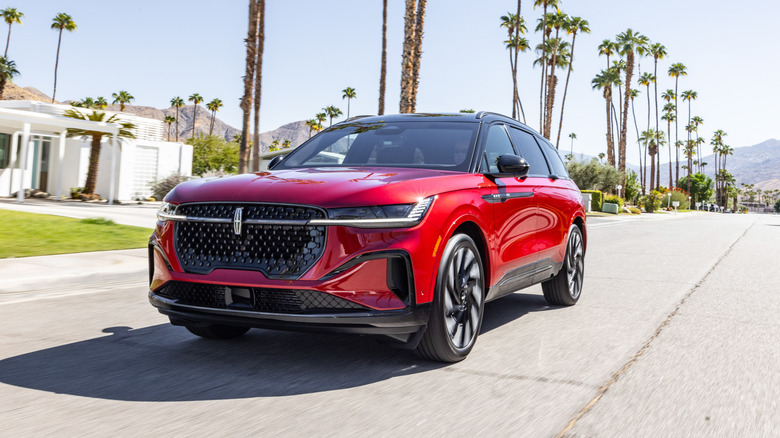
Turbocharging followed a long road to become mainstream in engines like Ford and Lincoln's EcoBoost. The first patent for a turbocharger was issued in 1905, but the metals and bearings available at the time couldn't stand up to the heat and pressure that turbos generated. Once metallurgy caught up to the technology, turbocharging was mainly used in ships, aircraft, and commercial diesel trucks. When turbos began to be used in passenger cars, manufacturers called attention to them using names like the Turbo-Rocket
V8 in the 1962 Oldsmobile Jetfire or the 1973 BMW 2002 Turbo.
Still, reliability issues and turbo lag kept them from gaining wide acceptance except as options in performance-oriented trim levels. However, today's turbos are more reliable, and they kick in at lower RPMs, boosting low-end torque. They've become a great way to get more power out of smaller displacements or fewer cylinders, and that's where Ford's EcoBoost lineup enters the story. Today, almost every new Ford model offers an EcoBoost engine, as do some Lincolns.
So if fuel economy is important to you, but you also want a car or truck that's peppy and fun to drive, there are several small-displacement EcoBoost engines to choose from. The sweet spot for some models may be the 2.0-liter EcoBoost, which offers a balance of power and efficiency for a small or midsize vehicle. Several past and present Ford and Lincoln models have come equipped with an Ecoboost.
Read more: Every Honda K-Series Engine Ranked From Worst To Best
Ford Maverick (2022-Present)
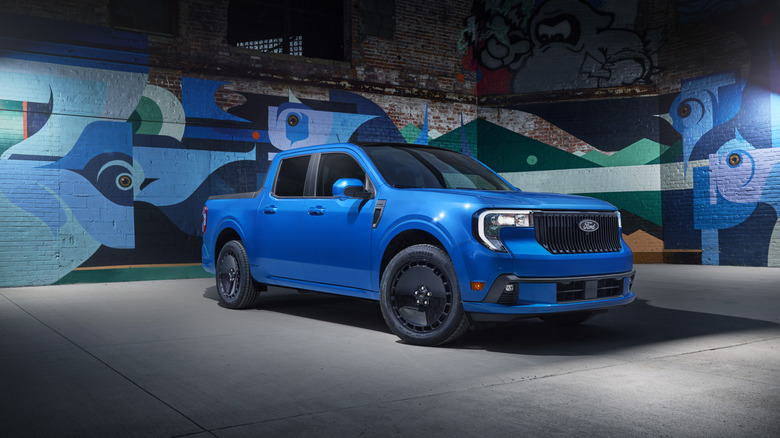
The Ford Maverick filled a void at the bottom of the pickup truck market when it was introduced in 2022, offering buyers a genuinely affordable, truly compact pickup in a market where trucks have gotten ever larger and more expensive. As a small, unibody pickup, the Maverick needed an efficient drivetrain to suit its economical dimensions, and it dutifully offers two of them. One is a 2.5-liter full hybrid drivetrain, and the other is the 2.0-liter EcoBoost.
For 2025, the 2.0-liter EcoBoost is standard on the Maverick Lobo and Tremor models and optional on the XL, XLT, and Lariat trim levels. This implies that it's the higher-performance drivetrain since the Lobo and Tremor are sporty trims, and the 2.0-liter pumps out 250 horsepower and 280 lb-ft of torque. These numbers easily exceed the efficiency-focused hybrid powertrain, which produces 191 horsepower and 155 lb-ft of torque. According to Ford, when properly equipped with a tow package, both models of the Ford Maverick can actually tow 4,000 pounds.
However, despite the identical tow ratings, the 2.0-liter EcoBoost has a substantial performance advantage. Car and Driver magazine tested both flavors of the 2025 Maverick and achieved a 0-60 time of 5.9 seconds from the 2.0-liter Ecoboost, compared to 7.7 seconds for the hybrid. The hybrid achieves substantially better mileage, getting 35 mpg on the highway versus the Ecoboost's 27 mpg, but the latter number is still excellent for a pickup with a 4,000-pound tow rating.
Ford Escape (2017-Present)
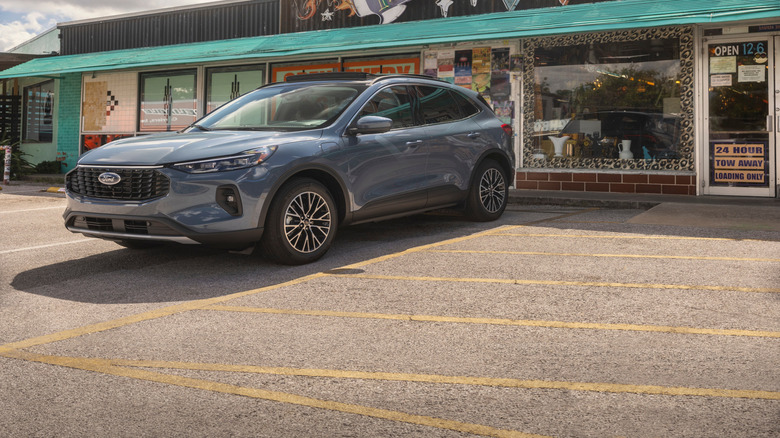
The Escape is Ford's entrant in the wildly popular compact SUV category. Ford's website cleverly pitches it as "your getaway car," helping you to escape the city with available all-wheel drive, a 1,500-pound tow rating, and 60.8 cubic feet of cargo space with the rear set stowed -- an impressive amount of room in a compact SUV. As a small vehicle, fuel efficiency is important, and the Escape offers three efficient drivetrains: a 1.5-liter EcoBoost (available only in the base Active trim), a 2.5-liter hybrid which is also available as a plug-in version, and since 2017, the 2.0-liter EcoBoost, which is currently available in the Escape's ST-Line Select, ST-Line Elite, and Platinum models.
In the Escape, the 2.0-liter generates the same power specs as in the Maverick: 250 horsepower and 280 lb-ft of torque. Auto Stop-Start is built in for extra fuel efficiency, although this may be an annoying car feature that you'd rather see gone. All-wheel drive is standard on the ST-Line Select and ST-Line Elite editions and available on the Platinum Edition, as well as the Active and ST-Line trim levels that don't offer the 2.0-liter EcoBoost.
Motor Trend reviewed the 2025 Escape and found the 2.0-liter EcoBoost (which they repeatedly refer to as the 2.0-liter turbo four) to be the most fun, declaring it "a more compelling option for folks who enjoy driving." The publication recorded a 0-60 time of 6.6 seconds with this engine, a full two seconds faster than the base 1.5-liter three-cylinder EcoBoost found in the Active edition.
Ford Bronco Sport (2021-Present)
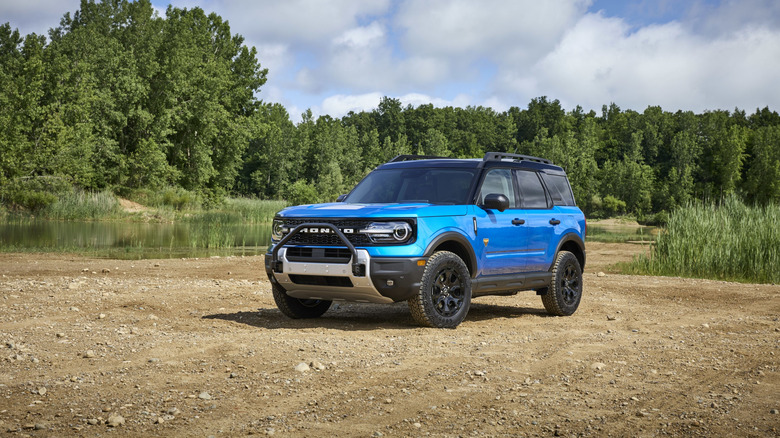
The Ford Bronco Sport is the baby Bronco, smaller than the just-plain-Bronco. It shares the same platform as the Escape and the Maverick, and unsurprisingly, it offers a similar range of engines, minus any hybrid option. The Big Bend, Heritage, and Outer Banks models feature the 1.5-liter EcoBoost three-cylinder, but the Badlands trim level comes with the 2.0-liter EcoBoost as its sole engine choice. The 2.0-liter has been available in various trims since the Bronco Sport debuted in 2021.
In the Bronco Sport, as in the Maverick and the Escape, the 2.0-liter EcoBoost generates 250 horsepower and 280 lb-ft of torque. Ford's multi-mode Advanced 4x4 system is also standard on the Badlands, delivering power to a single wheel if the other three have lost traction. An eight-speed automatic transmission is standard on this and all other trim levels of the Bronco Sport. Auto Stop-Start is standard, at least until an EPA rule change deletes this feature.
For 2025, the Bronco Sport offers new off-road trims as the Badlands and Outer Banks models are now available as Sasquatch Editions. This is a special off-road variant designed to compete with Rubicon versions of Jeep models, giving the littlest Bronco some decent off-road cred. It upgrades the ute with Ford's twin-clutch rear drive system for better 4x4 grip in low-traction conditions, all-terrain tires, and a rear-locking differential. The package also includes all-terrain tires, a 360-degree camera, and underbody and bumper protection.
Lincoln Corsair (2020-Present)

Lincoln seems oddly reluctant to refer to the 2.0-liter turbocharged engine in the Corsair as an EcoBoost engine. Prospective buyers won't find that label anywhere on the Corsair's product page. Instead, Linc refers to it as a "2.0L Turbocharged I-4 Engine with Auto Stop-Start Technology." But if we take a look at Motor Trend's 2023 review of the Corsair, which had just been refreshed into its current form for that model year, we do see the word EcoBoost, as well as confirmation that it's the same 2.0-liter engine found in the Escape. It has been available since the Corsair's first model year in 2020 and currently comes standard on the Premiere and Reserve trim levels.
Why won't Lincoln call it an EcoBoost? We can only speculate, but one reason could be the eco part of the EcoBoost name; Lincoln buyers are looking for luxury, not fuel economy. Or perhaps Lincoln's product planners didn't want buyers to associate the Corsair with its downscale Ford cousins, particularly the Escape. This might leave potential customers wondering whether the Corsair or the Escape is the best deal.
It's true that the Corsair's 2.0-liter EcoBoost engine generates the same 250 horsepower as its more affordable Ford cousin, good for a 6.1-second 0-60 time, according to Car and Driver. However, they note that the Lincoln offers an upscale interior with soft leather, adjustable ambient lighting, and a slew of other high-tech features, creature comforts, and special edition color schemes not found in lesser nameplates. This squares with our review of the 2025 Lincoln Corsair, which noted its luxurious touches and concluded that "it's not hard to like the Corsair."
Lincoln Nautilus (2019-Present)
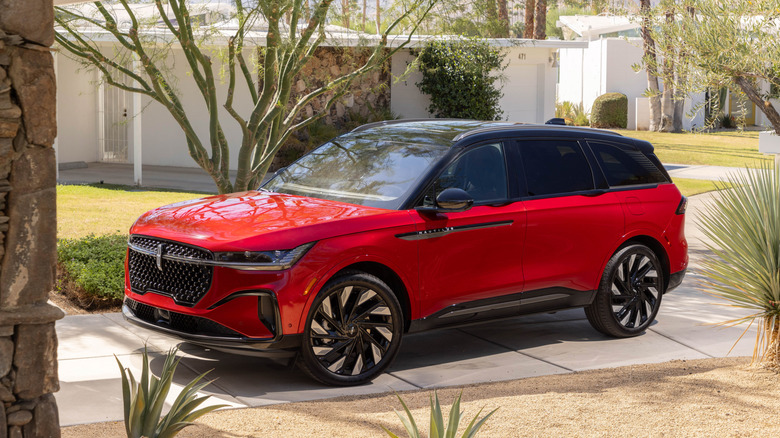
The midsize Nautilus is a step up from the Corsair in Lincoln's hierarchy in terms of both size and price. Yet it shares the same base engine, the 2.0-liter EcoBoost, although, as with the Corsair, you won't find the word EcoBoost anywhere near the Nautilus's promotional materials. But it's definitely our familiar 2.0-liter turbocharged friend under the Nautilus's hood, where it has been found in some trim levels since 2019. For 2025, it comes standard on every all-wheel-drive Nautilus with the eight-speed transmission, with the optional drivetrain being a 2.0-liter hybrid system paired with a CVT gearbox.
The Nautilus starts at nearly $52,000 and approaches $80,000 for a Black Label version, and yet it's powered by the same engine as a Ford Escape. So, what makes it stand out, especially in a very crowded midsize SUV segment with plenty of luxury contenders? As with its smaller Corsair stablemate, it positively bristles with luxury touches. In its review, TheDrive.com mentions the Nautilus's "interior of walnut and burnt sienna, endless screen, and crystalline volume knob. It also sports a fresh-looking exterior, having just been made over in 2024.
Our review of the 2025 Lincoln Nautilus Black Label came to much the same conclusion, saying that "despite gadget overload, the luxury feels genuine." For buyers seeking a vehicle that pampers them with sensory pleasure and tons of high-tech features, the Nautilus stands out from dozens of other interchangeable SUVs.
Ford Edge (2011-2024)
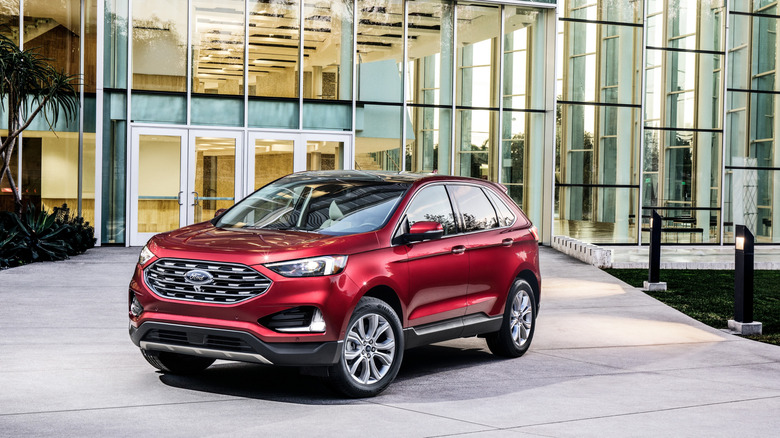
Ford debuted the Edge in 2007 and discontinued it in 2024, but the 2.0-liter EcoBoost engine was added to the Edge's engine choices in 2011, where it remained through 2024. The Edge was a midsize SUV with two-row seating, a roomy interior, and a stylish exterior with a noticeable Ford family grille. By 2024, prices started at just under $40,000 and scaled up to a bit under $49,000.
The priciest Edge was the V6 model, making the 2.0-liter EcoBoost an appealing option for drivers who weren't looking to win stoplight drag races. Fuel economy for the four-cylinder EcoBoost was rated at 21 mpg in the city and 28 mpg on the highway –- not world-beating numbers, but not terrible for a 4,357-pound SUV. It achieved 0-60 times in the ballpark of 7 seconds. The Edge also offered decent levels of equipment and features, including automated emergency braking, lane departure warning, and lane-keeping assistance, all included as standard features in the 2024 model.
Ford Focus ST (2012-2018)

A quick glance at the Ford website's model page will reveal that the only non-truck, non-SUV passenger vehicle remaining in its American inventory is the Mustang. So what happened to the Ford Focus? It was discontinued in the USA after 2018, and Ford recently announced it would end production worldwide after 2025 to make way for electric vehicles. More than a quarter of a century of being one of the world's best-selling small cars is quietly coming to an end.
During its last seven model years in the USA, Ford offered a 252-horsepower version of the 2.0-liter EcoBoost in the performance-oriented Focus ST, the second-highest performance variant after the track-focused Focus RS. With the Focus's compact-car weight and a required six-speed manual transmission, the little beast could hit the 0-60 mark in as little as 6.3 seconds. Checking the right option box would get buyers a set of Recaro sports seats, along with a premium stereo system and a sunroof.
Ford Fusion (2013-2017)
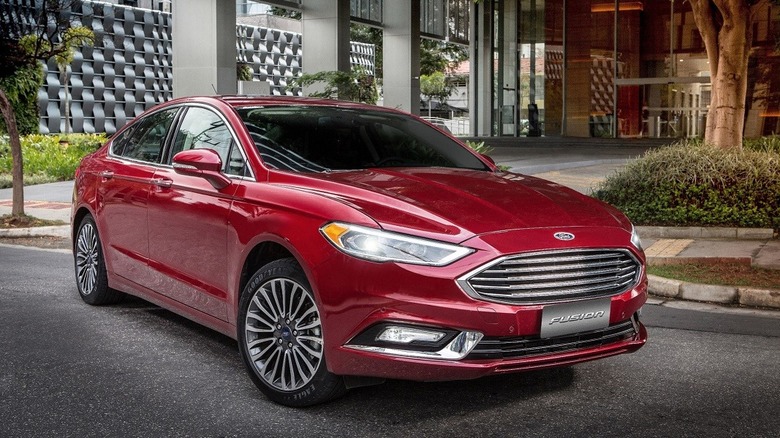
The Ford Fusion held down the fort for the Blue Oval in the midsize sedan category from 2006 through 2020 before giving way to the irresistible onslaught of SUVs and EVs. For five of those years, from 2013 through 2017, the Fusion offered the 2.0-liter EcoBoost as one of its base engines. For instance, in the 2014 model, a 240-horsepower version of the 2.0-liter EcoBoost sat at the top of the Fusion's engine list, and was the only powerplant offered in all-wheel drive models.
This engine also offered 270 lb-ft of torque. With an electronically controlled clutch, the AWD Fusion equipped with the 2.0-liter could direct that torque to every corner of the car in almost any driving conditions. It hit 0-60 times a shade over 7 seconds, and fuel economy clocked in at 22 mpg in the city and 31 mpg on the highway. The Fusion's AWD drivetrain and executive car good looks gave it a leg up on many of its competitors.
Lincoln MKC (2015-2018)
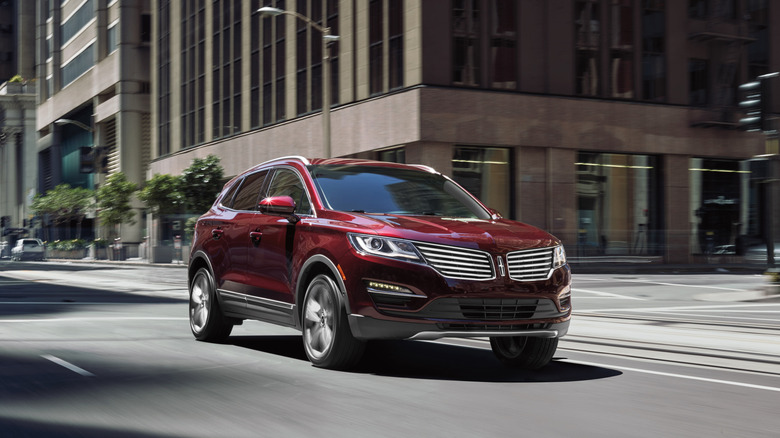
Before the Corsair, there was the MKC, Lincoln's earlier compact luxury crossover SUV. The MKC, like most Lincolns, oozed luxury on the inside, but it was less enchanting to look at than it was to sit behind the wheel. A 240 horsepower version of the 2.0-liter EcoBoost served as the base engine, generating 270 lb-ft of torque. As with its Corsair successor, it shared the powerplant with the Ford Escape, whose platform it was based on.
Even base models came with premium luxury touches like power-adjustable heated seats, blind spot monitors, dual-zone climate controls, and leatherette upholstery. The material quality and cabin layout were excellent. Bridge of Weir leather was optional, interior colors were sumptuous, and a dual sunroof let in the sun or moonlight. On the downside, crash test scores were mixed, and the MKC lacked some safety features that a buyer would expect in its segment.
Ford Taurus (2013-2017)
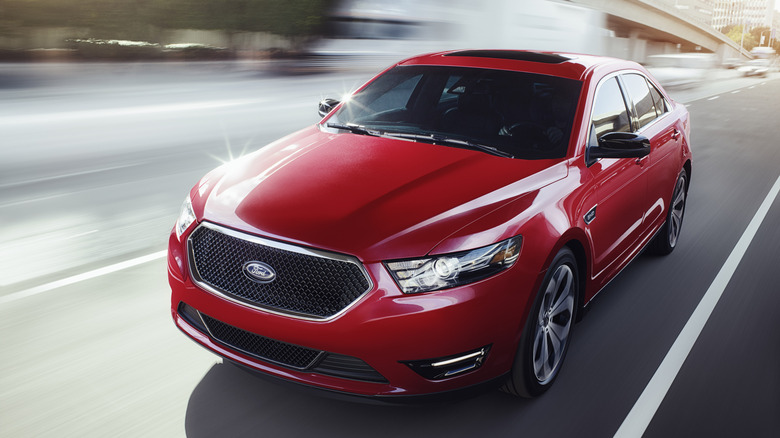
The Taurus was wildly popular early in its model history. The 1986 Ford Taurus was so important that it might have saved Ford. By the 2010s, the Taurus had grown into a full-sized model (after taking over the nameplate of the Ford 500). Yet despite the car's size, the 2.0-liter EcoBoost was available as a choice from 2013 through 2017, demonstrating the versatility of the engine.
While the 240-horsepower four-banger was somewhat challenged by the Taurus's weight, it was nevertheless a viable option for fuel economy-minded drivers. Most reviewers found the 2.0-liter to be more than adequate for everyday driving situations. It also offered respectable fuel-economy numbers for a full-sized car: 20 mpg in the city and 29 mpg on the highway. A six-speed automatic transmission came standard, which was somewhat outdated for its time period. Unlike the Fusion, the Taurus only offered the 2.0-liter EcoBoost in front-wheel drive models.
Lincoln MKZ (2012-2016)
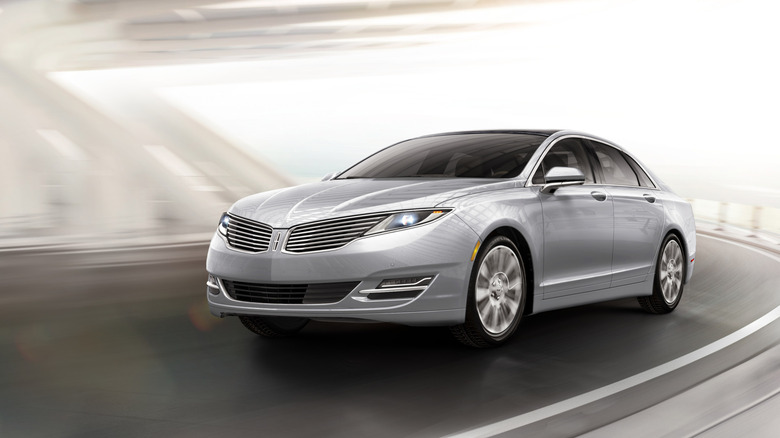
The Lincoln MKZ packed a vast retractable roof and stylish looks in the midsize luxury car segment. It also offered the 2.0-liter EcoBoost four-cylinder as a base engine from 2012 through 2016. In the 2016 model, it made 240 horsepower and 270 lb-ft of torque, all directed to the front wheel or all four wheels via a six-speed automatic transmission. It achieved 22 mpg in the city and 33 mpg on the highway in front-wheel drive form, although AWD knocked those numbers down a bit to 22 and 31, respectively.
The MKZ was a well-equipped sedan with a five-star safety rating. Optional luxury touches included heated and cooled front seats, heated rear seats, and a heated steering wheel, as well as the panoramic sunroof, numerous safety features including a blind spot warning, and an infotainment screen with MyLincoln Touch. Reviewers found it to be a confident driving machine, but more comfort-oriented than sporty.
Ford Explorer (2011-2015)
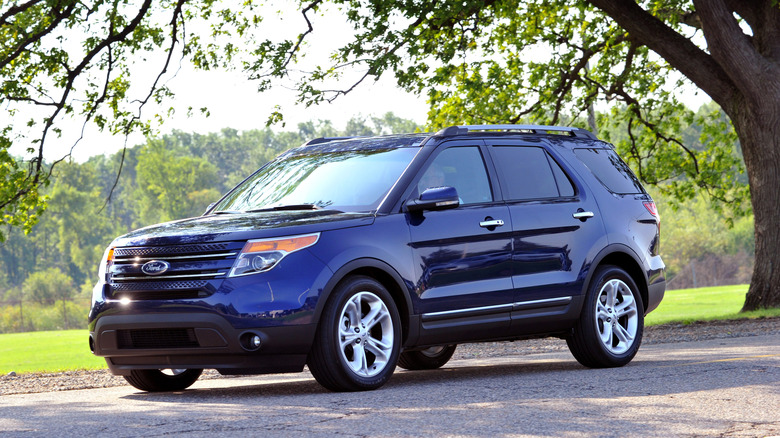
The venerable Ford Explorer has roamed American roads since all the way back in 1991, and this enduring model helped to popularize the SUV form factor as a standard American family-hauler. However, it only received the 2.0-liter EcoBoost for a short period of time between 2011 and 2015. These days, the smallest engine in the Explorer is the 2.3-liter, four-cylinder EcoBoost, and the 2.0-liter is no longer available.
In the 2015 Explorer, the 2.0-liter EcoBoost generated 240 horsepower and 270 lb-ft of torque, which is fairly close to today's numbers, although it required premium fuel to make maximum power. It came only in front-wheel drive Explorers and struggled a bit to move the SUV's fairly substantial weight. On the plus side, it offered a comfortable ride and optional third-row seating. And even in today's very competitive market, the Explorer ranks among the mid-size SUVs with the most cargo room.
Want the latest in tech and auto trends? Subscribe to our free newsletter for the latest headlines, expert guides, and how-to tips, one email at a time.
Read the original article on SlashGear.











